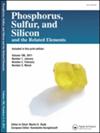An integrated absorption and electrolysis process to H2S treatment using alkaline ionic liquids aqueous solution
IF 1.4
4区 化学
Q4 CHEMISTRY, INORGANIC & NUCLEAR
Phosphorus, Sulfur, and Silicon and the Related Elements
Pub Date : 2025-05-04
DOI:10.1080/10426507.2025.2498438
引用次数: 0
Abstract
The electrolytic oxidation of H2S is a promising energy conversion technology for hydrogen production and the removal of this environmental pollutant. Additionally, the anode oxidation reactions offer the added advantage of obtaining valuable chemicals. Here, a series of alkaline ionic liquids ([DBNH]IM, [DBUH]IM, [DBNH][1,2,4-triaz], [NH4Cl][MEA], and [ChCl][MEA]) aqueous solutions were used as absorbents and anolytes for absorption-electrolysis cycles with pristine carbon cloth to enhance H2S absorption and electrolysis, coupling with efficient HER. [DBNH]IM-based electrolyte exhibited higher H2S trapping capacity primarily due to its ability in H2S absorption and modulation effect. Under constant potential electrolysis at 1.2 V vs RHE applied for 12 h, the maximum hydrogen production rate reached 1150 μmol h−1. Even after three cycles, the hydrogen production rate in [DBNH]IM-based system remained at approximately 185 μmol h−1. The anodic sulfur product can be separated from the electrolyte by bubbling CO2; solid product was confirmed to be α-sulfur as high as 99.207%. In summary, the obtained electrolyte demonstrates effective decomposition of H2S while simultaneously producing clean hydrogen and sulfur in a sustainable way.
采用碱性离子液体水溶液对H2S进行综合吸收电解处理
电解氧化H2S是一种很有前途的制氢和脱除环境污染物的能量转换技术。此外,阳极氧化反应提供了获得有价值的化学物质的额外优势。本研究采用碱性离子液体([DBNH]IM、[DBUH]IM、[DBNH][1,2,4-三az]、[NH4Cl][MEA]和[ChCl][MEA])水溶液作为吸附剂和电解质,与原始碳布进行吸附-电解循环,以增强H2S的吸收和电解,并结合高效HER。[DBNH] im基电解质具有较高的H2S捕获能力,主要是由于其对H2S的吸收和调制作用。在1.2 V vs RHE等电位条件下电解12 h,产氢率最高可达1150 μmol h−1。经过3次循环后,[DBNH] im体系的产氢速率仍保持在185 μmol h−1左右。通过鼓泡CO2可以将阳极硫产物从电解质中分离出来;固体产物α-硫含量高达99.207%。综上所述,所获得的电解质能够有效分解H2S,同时以可持续的方式产生清洁的氢和硫。
本文章由计算机程序翻译,如有差异,请以英文原文为准。
求助全文
约1分钟内获得全文
求助全文
来源期刊
CiteScore
2.60
自引率
7.70%
发文量
103
审稿时长
2.1 months
期刊介绍:
Phosphorus, Sulfur, and Silicon and the Related Elements is a monthly publication intended to disseminate current trends and novel methods to those working in the broad and interdisciplinary field of heteroatom chemistry.

 求助内容:
求助内容: 应助结果提醒方式:
应助结果提醒方式:


